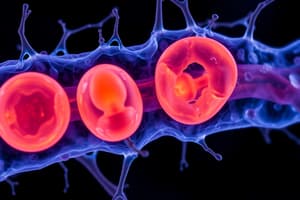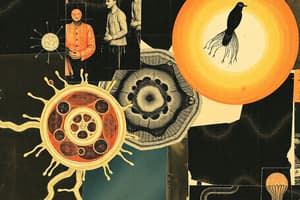Podcast
Questions and Answers
Which part of the mitochondria contains DNA, RNA, and ribosomes?
Which part of the mitochondria contains DNA, RNA, and ribosomes?
- Outer membrane
- Cristae
- Matrix (correct)
- Inner membrane
What is the main function of peroxisomes?
What is the main function of peroxisomes?
- Protein synthesis
- FA β-oxidation and H2O2 production (correct)
- Cell signaling
- Cell division
What is the function of the cristae in the mitochondria?
What is the function of the cristae in the mitochondria?
- Site of DNA replication
- Storage of cellular waste
- Site of protein synthesis
- Increase surface area for ATP production (correct)
Which type of cells would have a prominent RER?
Which type of cells would have a prominent RER?
What is the primary function of the outer membrane of mitochondria?
What is the primary function of the outer membrane of mitochondria?
Which organelle is involved in apoptosis?
Which organelle is involved in apoptosis?
What is the main function of the inner membrane of mitochondria?
What is the main function of the inner membrane of mitochondria?
What is the function of the matrix in mitochondria?
What is the function of the matrix in mitochondria?
What is the function of proteasomes in cells?
What is the function of proteasomes in cells?
What is the primary function of the stroma in organs?
What is the primary function of the stroma in organs?
What is the name of the vesicle formed when a lysosome fuses with a transport vesicle?
What is the name of the vesicle formed when a lysosome fuses with a transport vesicle?
Which of the following is NOT a type of tissue?
Which of the following is NOT a type of tissue?
What is the term for the process of cellular component turnover?
What is the term for the process of cellular component turnover?
Which germ layer gives rise to the gut tube epithelium and luminal epithelial derivatives?
Which germ layer gives rise to the gut tube epithelium and luminal epithelial derivatives?
What is the term for the remains of indigested material in a lysosome?
What is the term for the remains of indigested material in a lysosome?
What is the primary function of the parenchyma in organs?
What is the primary function of the parenchyma in organs?
Which type of cells have a prominent nucleolus and produce ground substance and extracellular fibers?
Which type of cells have a prominent nucleolus and produce ground substance and extracellular fibers?
What is a characteristic feature of the cytoplasm of a Mast Cell?
What is a characteristic feature of the cytoplasm of a Mast Cell?
Which gland type has several sac-like secretory units with small ducts that converge at a larger duct?
Which gland type has several sac-like secretory units with small ducts that converge at a larger duct?
What is the primary function of a Plasma Cell?
What is the primary function of a Plasma Cell?
What is a characteristic feature of an Adipocyte?
What is a characteristic feature of an Adipocyte?
Which cell type has an eccentric, kidney-shaped nucleus?
Which cell type has an eccentric, kidney-shaped nucleus?
What is a characteristic feature of the nucleus of a Fibrocyte?
What is a characteristic feature of the nucleus of a Fibrocyte?
Which gland type has several elongated coiled secretory units and their ducts that converge to form larger ducts?
Which gland type has several elongated coiled secretory units and their ducts that converge to form larger ducts?
What is released by Mast Cells?
What is released by Mast Cells?
Which cell type is involved in phagocytosis and immune functions?
Which cell type is involved in phagocytosis and immune functions?
From which germ layer do cartilages arise during embryonic development?
From which germ layer do cartilages arise during embryonic development?
What is the primary function of proton pumps in cartilage cells?
What is the primary function of proton pumps in cartilage cells?
What is the main difference between interstitial and appositional growth in cartilage?
What is the main difference between interstitial and appositional growth in cartilage?
What is the primary reason for the poor capacity of cartilage to repair itself?
What is the primary reason for the poor capacity of cartilage to repair itself?
What is the most abundant inorganic component of bone matrix?
What is the most abundant inorganic component of bone matrix?
What is the primary function of type I collagen in bone matrix?
What is the primary function of type I collagen in bone matrix?
What type of secretion do both eccrine and apocrine sweat glands undergo?
What type of secretion do both eccrine and apocrine sweat glands undergo?
Which of the following is NOT a functional division of the immune system?
Which of the following is NOT a functional division of the immune system?
What type of granules do granulocytes have?
What type of granules do granulocytes have?
What is the function of Hassall corpuscles in the thymus?
What is the function of Hassall corpuscles in the thymus?
What is the site of T cell production in the thymus?
What is the site of T cell production in the thymus?
Which type of leukocyte has a bilobed nucleus?
Which type of leukocyte has a bilobed nucleus?
What is the name of the barrier between the cortex and medulla of the thymus?
What is the name of the barrier between the cortex and medulla of the thymus?
Which type of leukocyte has a kidney-shaped nucleus?
Which type of leukocyte has a kidney-shaped nucleus?
What is the sequence of leukocyte counts in the blood from highest to lowest?
What is the sequence of leukocyte counts in the blood from highest to lowest?
What is the term for the process by which leukocytes migrate out of the blood vessels and into the tissues?
What is the term for the process by which leukocytes migrate out of the blood vessels and into the tissues?
Flashcards are hidden until you start studying
Study Notes
Cell Biology
- The cell has various organelles, including mitochondria, peroxisomes, lysosomes, and proteasomes.
- Mitochondria have inner and outer membranes, with the inner membrane forming cristae to increase surface area for ATP production.
- Peroxisomes contain oxidative enzymes and are involved in beta-oxidation, H2O2 production, and detoxification.
- Lysosomes have a membrane-bound acidic compartment for intracellular digestion and contain hydrolytic enzymes.
- Proteasomes are cylinder-shaped with no membrane and degrade denatured, non-functional, or unneeded proteins.
Tissue Types
- There are four basic tissue types: epithelial, connective, muscle, and nervous.
- Epithelial tissue covers organs and forms glands, while connective tissue provides support and connects organs.
- Muscle tissue is responsible for movement, and nervous tissue is responsible for transmission and integration of signals.
Embryonic Germ Layers
- There are three embryonic germ layers: ectoderm, mesoderm, and endoderm.
- Ectoderm gives rise to the nervous system, skin, and sensory organs.
- Mesoderm forms muscle, bone, connective tissue, blood vessels, and the dermis.
- Endoderm develops into the gut tube epithelium and luminal epithelial derivatives.
Germ Layer Derivatives
- A comprehensive list of germ layer derivatives can be found in the appendix.
Compound Glands
- Compound glands have multiple secretory units that converge to form larger ducts.
- Examples include the pancreas, salivary glands, and mucous glands in the duodenum.
Cell Structure and Function
- Cells have different structures and functions, such as fibroblasts, adipocytes, macrophages, and mast cells.
- Fibroblasts produce ground substance and extracellular fibers, while adipocytes store neutral fats and have a single huge lipid droplet.
- Macrophages are involved in phagocytosis and immune functions, and mast cells release heparin, histamine, and cytokines.
Cartilage
- Cartilage growth involves interstitial and appositional growth, with chondroblasts differentiating from mesenchymal cells.
- Cartilage degeneration involves calcification, age-related changes, and poor capacity for repair.
Bone Matrix
- Bone matrix consists of inorganic components (calcium hydroxyapatite, non-crystalline calcium phosphate, and ions) and organic components (type I collagen, proteoglycans, and glycoproteins).
Lymphoid and Immune System
- The immune system has two functional divisions: innate immunity (non-specific, mediated by granulocytes) and adaptive immunity (specific, mediated by lymphocytes and antigen-presenting cells).
- Leukocytes are divided into granulocytes and agranulocytes, with granulocytes having polymorphic nuclei and cytoplasmic granules.
- Agranulocytes lack specific granules but have some lysosomes, with spherical, non-lobulated nuclei.
Thymus
- The thymus is a bilobed mediastinal structure where T cells are produced, originating from the 3rd pharyngeal pouches (endoderm).
- The thymus has a cortex (outer darkly basophilic portion with T lymphoblasts, macrophages, and thymic epithelial cells) and medulla (lightly-stained inner portion with mature lymphocytes and TECs).
- Thymic epithelial cells (TECs) are diverse and important for the development and activity of regulatory T cells.
Studying That Suits You
Use AI to generate personalized quizzes and flashcards to suit your learning preferences.



